How to Nail Your First Pull-up or Chin-up Even if You Can Barely Hang From the Bar
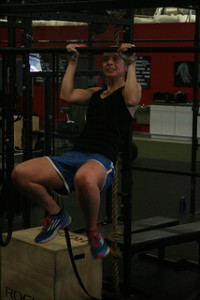
“How do I get my first pull-up?” is probably one of the most frequently asked questions I’ve received over the years, and I just got another one last week from a gal named Reeze…
QUESTION: “I have always wanted to be able to do a pull-up. While I have no injuries, I am extremely weak as well as a woman in my 50s. I can’t even pull myself up at all, not even an inch! Is there help for me?” -Reeze
ANSWER:
I’ve said it before and I’ll say it again. Anyone with two good arms can get better at pull-ups – period. It doesn’t matter if you’re male, female, old, young, fat or fit. With proper training, practically anyone can work up to performing pull-ups without assistance. Yes – just like they do ’em in the Marine Corps. Shouting “Ooh Rah” is optional, of course.
Now, obviously, that doesn’t mean that getting better at pull-ups is easy – quite the opposite, in fact. It’s actually a very challenging exercise for people from all walks of life – and of all shapes and sizes, too. And for some, it may seem darn-near impossible to achieve. In fact, many people have spent their entire life being unable to do one.
However, if you have enough desire and the will to succeed, and you decide ahead-of-time that you’re going to work hard and persevere when the going gets tough, then it’s only a matter of time before you nail your first pull-up – with excellent technique, I might add. Here are a few simple things you can do to make that happen sooner than later.
The Top 3 Things You Can do to Nail Your First Pull-up
1) Learn how to apply all of your body’s strength in the pull-up exercise instead of just trying to use your arm and back muscles. A lot of trainers will teach you that you need to isolate your muscle groups when performing strength training, but that’s like selling yourself short every time you train. The truth is that it’s impossible to truly isolate any one muscle group, and the body is actually much stronger when it’s integrated as a whole. And so, it makes sense to train it this way because you’ll perform better and get stronger as a result.
You can capitalize on this idea by learning how to integrate a number of key components into your pull-up technique to make sure that you are, in fact, employing as much of your body’s strength as possible. Most people notice an immediate improvement in their performance (i.e., feeling much stronger) once they learn how to perform pull-ups not just properly, but optimally, thereby turning the pull-up from a “back and bi’s” exercise into a full body movement.
Click Here to Learn the Best Way to Perform Pull-ups, Chin-ups and other Similar Exercises
I’ve been told this is the most complete, detailed, and thorough pull-up technique tutorial on the internet, and I think they’re right. And it’s because I look at the pull-up holistically, instead of just fixating on the main points that most people learned in gym class. So, if you haven’t seen it yet, the video tutorial is a must-watch. You’ll never look at pull-ups the same way again.
Now, knowing how to optimize your pull-up technique might not be enough for you to get your first pull-up. And if that’s the case, then your job is to apply those key components to an appropriate substitute exercise that will help you work up to it.
2) Choose the most difficult pullup-specific exercise you can manage to perform with good technique and work your way up the ladder towards full, unassisted pull-ups. If you can’t do pull-ups yet, then one of the best things you can do is to practice it’s building blocks. So, if you can’t do full pull-ups, do assisted pull-ups with a resistance band or partner. Or, just setup a platform below the pull-up bar (e.g. can be a chair or bench) to either push off of with your feet or to jump from. And if assisted pull-ups are too difficult, then practice performing negative repetitions (i.e., just the lowering portion of the exercise). If that’s too hard, then practice holding the top position of the pull-up for time (aka the flexed-arm hang). And if that’s too hard, you can simply hang from the bar with your arms straight, elbows locked, while still maintaining proper alignment and tension throughout your set.
Beginner Level Pull-up Variations (the building blocks of pull-ups)
Here are some basic descriptions of some of the beginner-level pull-up exercises I mentioned above…
Deadhang – This exercise involves holding onto a pull-up bar and hanging with the proper tension in the body to activate the musculature involved in the pull-up exercise. There’s a little bit more too it than that (a lot, actually!), but that’s the gist of it. But at its most basic level, you just grab onto a bar and hold on for as long as you can. It’s a good beginner-level isometric exercise for building up to pull-ups and chin-ups.
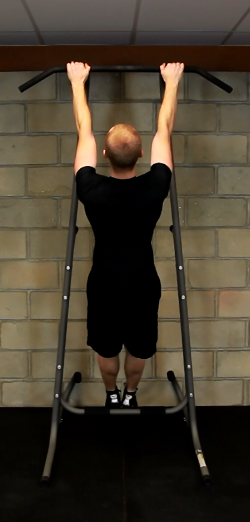
Flexed-Arm Hang – This is another isometric exercise that involves holding yourself in the top position of the pull-up exercise for as long as possible, and again, while maintaining the proper tension in the body to activate and strengthen the musculature involved in the pull-up exercise. It’s another good stepping stone to full, unassisted pull-ups.
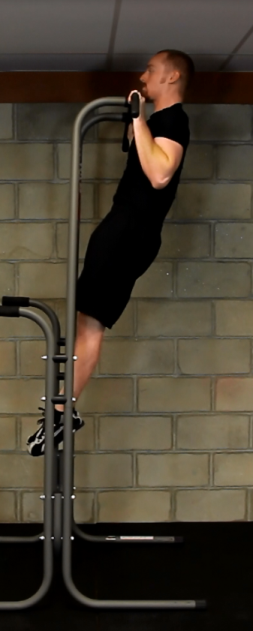
Assisted Repetitions – If you can almost do a full pull-up or chin-up, then performing assisted repetitions might be a good idea. This involves moving through the full range of motion of the pull-up exercise, but using some form of assistance or support to help you throughout each repetition. There are many ways to do them, such as with a partner to help you, using a resistance band, bench, or even jumping to help you get up to the bar each repetition. The key is finding a method that works for you and will tap into the “sweet spot” of strength adaptation.
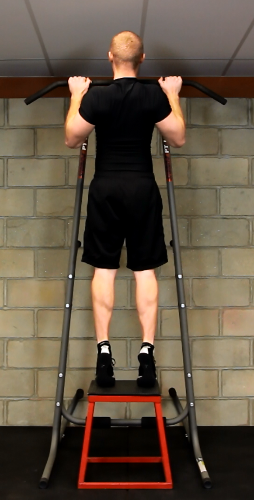
And there are even easier variations than that, if necessary – and many “in-between” variations to help you find the sweet spot that will help you get stronger. The point is that you want to practice the closest thing to a pull-up as possible in order to build the specific strength to get better at them. Specificity is the key! A common mistake made by pull-up training hopefuls is to simply exercise the muscle groups involved in the pull-exercise (e.g. back and arm muscles) without any use of specificity.
Even some researchers with PhDs made that mistake in a recent study done at the University of Dayton. They gave 17 women who couldn’t do a single pull-up a 3-month exercise program in hopes of helping them do their first pull-up. By the end of the study, only 4 of them had succeeded, and the researchers concluded that women just can’t do pull-ups. Fortunately, we all know what a load of nonsense that was. Women CAN do pull-ups after all, and old guys can, too, in case you were wondering. And the best way to get better at them is with specificity, which any good strength coach worth their papers would tell you – no lab coat required.
So, in essence, do assisted pull-ups if you can, flexed-arm hangs if you can’t, and a deadhang if absolutely necessary. And keep in mind that there are many ways to augment each exercise to make it easier/harder depending on your conditioning level. Your goal should be to find the most challenging variation you can manage with good technique, and practice it regularly.
3) Practice your chosen pull-up exercise as frequently as possible, at a sub-maximal intensity. Simply put, the more you practice, the better you’ll get. And in order to practice often, you’ll need to do so at a low to moderate exertion level (i.e., at a sub-maximal intensity). So, one of the most effective methods I have found to rapidly increase your strength in any given exercise is the grease the groove technique (aka GTG). This is a really effective protocol for a number of reasons, and offers superb results over short periods of time. You can get some basic instructions on how to perform it here (see Instructions for Month 1 of the program for the GTG section): How to Rapidly Increase Your Pull-up Numbers in 3 Months or Less
Note: Coincidentally, that is the most popular post on my entire website (over 750,000 views), and tons of people have used that beta-version of my pull-up training program with phenomenal success – most of whom noticed a dramatic improvement in their performance in just the first few weeks, all thanks to the GTG technique. This stuff works.
Summary & Key Points
If you want to do your first pull-up, then basically, you need to learn the optimal way to perform the technique in order to draw from your whole body’s strength and maximize your performance from the start. Next, you need to choose an appropriate pull-up exercise (aka building blocks) that will be suitable for your conditioning level, and then practice perfect technique each and every time you train with a goal of working your way up the difficulty levels toward full pull-ups. And finally, you need to practice that technique as frequently as possible at a sub-maximal intensity – preferably using a method such as the Grease the Groove Technique. That is a very simple way to get a big headstart on your pull-up training aspirations.
Here are some milestones to check off as you go along…
Level 1 goal: hold a Deadhang for 30-60 seconds
Level 2 goal: hold a Flexed-arm hang for 30-60 seconds
Level 3 goal: perform 3-5 sets of negative repetitions in the 3-8 rep range
Level 4 goal: perform 3-5 sets of assisted repetitions in the 3-8 rep range
Work your way up through the levels and I bet you’ll impress yourself with the results.
The Bottom Line
The bottom line is that pull-ups are hard for everyone from all walks of life. And if you are someone who has struggled with pull-ups for years or even your entire life, then it’s probably a safe bet to assume your results will come a bit slower than your average 20-something “lean and mean” male who is surging with testosterone. But that doesn’t change the fact that anyone can get better at pull-ups. And if you apply these three tips, you’ll be well on your way to doing your first, unassisted pull-up – and beyond.
So, if you’ve ever been stuck, frustrated, or even mad that you can’t get better at pull-ups and chin-ups, and you’d like a step-by-step system that will take you by the hand and show you EXACTLY what you need to do in order to rapidly increase your pull-up strength and performance – no matter who you are or what your starting point is – then allow me to introduce you to the most effective pull-up and chin-up training system currently available, that is ideal for beginners and even ultra-beginners who are struggling to get their first pull-up.
So, if you’re tired of struggling with pull-ups and you’d like not just a few tips, but an entire system that will walk you step-by-step through the process of getting better at them, then check out The Pull-up Solution at the link below.
Click Here to Learn More About The Pull-up Solution
If you found this article helpful, please share it with your friends and tweeps:
.jpg)
![]()
Health-First Fitness Coach
P.S. If you liked this post, then please signup for the newsletter, or follow me on Facebook or Twitter for daily updates and other interesting info.
Photo credit: http://www.flickr.com/photos/99893370@N03/

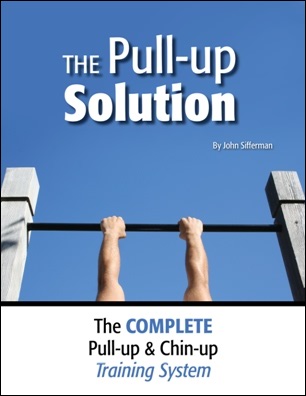
Hi John, Your articles are great and I feel there is light at the end of the tunnel to get me to that final stage. I used to be able to do chin ups and pull ups many years ago when I was lighter however after 2 kids and also now that I lift a lot heavier weights and do strength training etc my weight has increased and I can’t seem to get that last bit of strength to get above the bar. I am at the stage of using a band to do an assisted pull, a light band, but other female friends of mine have recommended doing negative pull ups rather than using the band ie jumping above the bar then lowering themselves slowly on a 5 sec etc count. I also have read your other article which says you don’t necessarily favour bands so I just wondered which technique u feel would be better to get me to the final stage of achieving a full up ie continued use of the small band or the negative pull up method of using the jump then slowly lowering myself technique ?
Hi Anita,
Great question! Both methods work, and I think you can and should use both of them. The key is intensity and effort. So, whichever pull up exercise is harder for you, that’s the one that you should focus on because it will help you build strength (as opposed to endurance, etc.).
So, I’d prioritize whichever one you feel challenges you more strength-wise. For example, if can do more assisted reps than negative pull ups, spend most of your time focusing on negative pull ups. And then at the end of your sessions, perform a set or two of assisted reps with the band for a little extra stimulus. On the flip side, if you can do more negative reps than assisted reps, I think you should focus on the assisted pull ups, since you’ll be working in more of a “strength zone,” which is what you need to build up to your first pull up.
But again, effort is the key, and you can achieve your goal with either method. I think that most people gravitate towards negative pull ups because bands can sometimes be used for too much assistance, which pulls you away from that strength training “sweet spot” I mentioned in the article above. Not to mention that you are supporting ALL of your weight with negative pull ups.
Let me know if you have any further questions – happy to help! And please let me know once you nail you first pull-up – would love to hear from you!
-John
I just discovered your website and videos last night after googling “pullups and chinups.” Your method is so refreshing, analytical and clear. Thanks for your positivity and encouragement. I’m a 69 yr old guy, could only do 3 pullups in high school, and have managed to get up to 7 with sloppy technique. While I am in a weight and fitness program, I am doing bicycling and pullups on my off days. I will pracataice your technique and hope for great results over the next few weeks. Thank you SO MUCH for removing the “hot dog” attitude from exercise. I’ve I had encountered this years ago, I would have kept fit. You’re a good motivator.
Ok, so I can only do the flexed arm hang in chin-up position for 10 seconds. I can almost do 1 chin-up ( I get to the top of my head ). How soon after 1 flexed arm hang should I attempt another? I obviously need to get to 60 seconds before I should attempt negative chin-ups. Should I switch my grip between pull-ups and chin-ups during reps ( chin-ups are easier )? Or should I be starting with deadhang, and if so how many reps and how much rest in between? I’m 5′ 8″ and about 195 lbs. I surf regularly, but I’m looking to loose some weight.